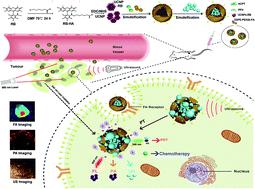当前位置:
X-MOL 学术
›
Biomater. Sci.
›
论文详情
Our official English website, www.x-mol.net, welcomes your
feedback! (Note: you will need to create a separate account there.)
A nanosystem loaded with perfluorohexane and rose bengal coupled upconversion nanoparticles for multimodal imaging and synergetic chemo-photodynamic therapy of cancer.
Biomaterials Science ( IF 5.8 ) Pub Date : 2020-05-06 , DOI: 10.1039/c9bm02081k Hai-Yan Wang 1 , Li Hou 2 , Hai-Liang Li 3 , Xu Wang 4 , Yang Cao 5 , Bo-Yu Zhang 6 , Jing-Tao Wang 7 , Shi-Jie Wei 8 , Hong-Wan Dang 8 , Hai-Tao Ran 5
Biomaterials Science ( IF 5.8 ) Pub Date : 2020-05-06 , DOI: 10.1039/c9bm02081k Hai-Yan Wang 1 , Li Hou 2 , Hai-Liang Li 3 , Xu Wang 4 , Yang Cao 5 , Bo-Yu Zhang 6 , Jing-Tao Wang 7 , Shi-Jie Wei 8 , Hong-Wan Dang 8 , Hai-Tao Ran 5
Affiliation

|
Theranostics is a new trend integrating diagnostic and therapeutic functions in tumour research. Theranostic nanoparticles enabling both tumour imaging and drug delivery are a promising platform for image-guided cancer therapy. Photodynamic therapy (PDT) has great potential in synergy with traditional chemotherapy but faces great challenges due to hypoxia, poor targeting ability and the limited penetration depth of visible light. To solve these problems, we presented a novel nanosystem of FA/UCNPs-RB/HCPT/PFH@lipid (denoted as FURH-PFH-NPs), with a perfluorohexane (PFH) carrying rich oxygen core and a folic acid-modified lipid shell. The shell contains 10-hydroxycamptothecin (HCPT) and self-fluorescing photosensitizer compounds, namely, upconversion nanoparticles and rose bengal (UCNPs-RB). In this study, FURH-PFH-NPs aggregated in SKOV3 cells (in vitro) and the nude xenograft tumour region when combined with folic acid receptors. When triggered by low-intensity focused ultrasound (LIFU), FURH-PFH-NPs released PFH, UCNPs-RB and HCPT. The above procedure was monitored through multimodal imaging, which simultaneously guided the tumour therapy. UCNPs-RB and PFH promoted the PDT effect under LIFU. Through PDT and HCPT, we obtained better therapeutic effects and good biosafety against SKOV3 nude xenograft tumours. FURH-PFH-NPs combined with LIFU and laser irradiation might be a promising strategy for ovarian cancer.
中文翻译:

装有全氟己烷和玫瑰孟加拉耦合的上转换纳米粒子的纳米系统,用于癌症的多峰成像和协同化学光动力疗法。
治疗学是在肿瘤研究中整合诊断和治疗功能的新趋势。能够同时进行肿瘤成像和药物递送的治疗性纳米颗粒是用于图像指导的癌症治疗的有前途的平台。光动力疗法(PDT)在与传统化学疗法的协同作用中具有巨大潜力,但由于缺氧,靶向能力差和可见光穿透深度有限而面临巨大挑战。为了解决这些问题,我们提出了一种新型的FA / UCNPs-RB / HCPT / PFH @脂质脂质体(称为FURH-PFH-NPs),其全氟己烷(PFH)带有丰富的氧核和叶酸修饰的脂质壳。壳包含10-羟基喜树碱(HCPT)和自发荧光的光敏剂化合物,即上转换纳米颗粒和玫瑰红(UCNPs-RB)。在这个研究中,当与叶酸受体结合时,FURH-PFH-NPs聚集在SKOV3细胞中(体外)和裸露的异种移植肿瘤区域。当由低强度聚焦超声(LIFU)触发时,FURH-PFH-NPs释放PFH,UCNPs-RB和HCPT。通过多模态成像监测上述过程,同时引导肿瘤治疗。UCNPs-RB和PFH在LIFU下促进了PDT的作用。通过PDT和HCPT,我们对SKOV3裸鼠异种移植肿瘤获得了更好的治疗效果和良好的生物安全性。FURH-PFH-NPs与LIFU和激光照射相结合可能是卵巢癌的一种有前途的策略。通过多模态成像监测上述过程,同时引导肿瘤治疗。UCNPs-RB和PFH在LIFU下促进了PDT的作用。通过PDT和HCPT,我们对SKOV3裸鼠异种移植肿瘤获得了更好的治疗效果和良好的生物安全性。FURH-PFH-NPs与LIFU和激光照射相结合可能是卵巢癌的一种有前途的策略。通过多模态成像监测上述过程,同时引导肿瘤治疗。UCNPs-RB和PFH在LIFU下促进了PDT的作用。通过PDT和HCPT,我们对SKOV3裸鼠异种移植肿瘤获得了更好的治疗效果和良好的生物安全性。FURH-PFH-NPs与LIFU和激光照射相结合可能是卵巢癌的一种有前途的策略。
更新日期:2020-03-11
中文翻译:

装有全氟己烷和玫瑰孟加拉耦合的上转换纳米粒子的纳米系统,用于癌症的多峰成像和协同化学光动力疗法。
治疗学是在肿瘤研究中整合诊断和治疗功能的新趋势。能够同时进行肿瘤成像和药物递送的治疗性纳米颗粒是用于图像指导的癌症治疗的有前途的平台。光动力疗法(PDT)在与传统化学疗法的协同作用中具有巨大潜力,但由于缺氧,靶向能力差和可见光穿透深度有限而面临巨大挑战。为了解决这些问题,我们提出了一种新型的FA / UCNPs-RB / HCPT / PFH @脂质脂质体(称为FURH-PFH-NPs),其全氟己烷(PFH)带有丰富的氧核和叶酸修饰的脂质壳。壳包含10-羟基喜树碱(HCPT)和自发荧光的光敏剂化合物,即上转换纳米颗粒和玫瑰红(UCNPs-RB)。在这个研究中,当与叶酸受体结合时,FURH-PFH-NPs聚集在SKOV3细胞中(体外)和裸露的异种移植肿瘤区域。当由低强度聚焦超声(LIFU)触发时,FURH-PFH-NPs释放PFH,UCNPs-RB和HCPT。通过多模态成像监测上述过程,同时引导肿瘤治疗。UCNPs-RB和PFH在LIFU下促进了PDT的作用。通过PDT和HCPT,我们对SKOV3裸鼠异种移植肿瘤获得了更好的治疗效果和良好的生物安全性。FURH-PFH-NPs与LIFU和激光照射相结合可能是卵巢癌的一种有前途的策略。通过多模态成像监测上述过程,同时引导肿瘤治疗。UCNPs-RB和PFH在LIFU下促进了PDT的作用。通过PDT和HCPT,我们对SKOV3裸鼠异种移植肿瘤获得了更好的治疗效果和良好的生物安全性。FURH-PFH-NPs与LIFU和激光照射相结合可能是卵巢癌的一种有前途的策略。通过多模态成像监测上述过程,同时引导肿瘤治疗。UCNPs-RB和PFH在LIFU下促进了PDT的作用。通过PDT和HCPT,我们对SKOV3裸鼠异种移植肿瘤获得了更好的治疗效果和良好的生物安全性。FURH-PFH-NPs与LIFU和激光照射相结合可能是卵巢癌的一种有前途的策略。







































 京公网安备 11010802027423号
京公网安备 11010802027423号